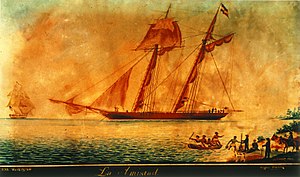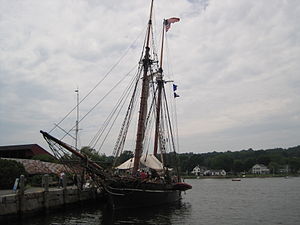La Amistad
 |
|
| History | |
|---|---|
|
|
|
| Name: | Friendship |
|
|
|
| Name: | La Amistad |
| Owner: | Don Ramon Ferrer |
|
|
|
| Name: | Ion |
| Owner: | Captain George Hawford, Newport, Rhode Island |
| Acquired: | 1840 |
|
|
|
| Acquired: | 1844 |
| General characteristics | |
| Length: | 120 ft (37 m) |
| Sail plan: | schooner |

Freedom Schooner Amistad at Mystic Seaport in 2010.
|
|
|
|
|
|---|---|
| Owner: |
|
| Builder: | Mystic Seaport |
| Laid down: | 1998 |
| Launched: | 25 March 2000 |
| General characteristics | |
| Tons burthen: | 136 L. tons |
| Length: | 80.7 ft (24.6 m) |
| Beam: | 22.9 ft (7.0 m) |
| Draft: | 10.1 ft (3.1 m) |
| Propulsion: | Sail, 2 Caterpillar diesel engines |
| Sail plan: | Topsail schooner |
Coordinates: 41°21′40″N 71°57′58″W / 41.361°N 71.966°W
La Amistad (pronounced: [la a.misˈtað]; Spanish for Friendship) was a 19th-century two-masted schooner, owned by a Spaniard living in Cuba. It became renowned in July 1839 for a slave revolt by Mende captives, who had been enslaved in Sierra Leone, and were being transported from Havana, Cuba to their purchasers' plantations. The African captives took control of the ship, killing some of the crew and ordering the survivors to sail the ship to Africa. The Spanish survivors secretly maneuvered the ship north, and La Amistad was captured off the coast of Long Island by the brig USS Washington. The Mende and La Amistad were interned in Connecticut while federal court proceedings were undertaken for their disposition. The owners of the ship and Spanish government claimed the slaves as property; but the US had banned the African trade and argued that the Mende were legally free.
Because of issues of ownership and jurisdiction, the case gained international attention. Known as United States v. The Amistad (1841), the case was finally decided by the Supreme Court of the United States in favor of the Mende, restoring their freedom. It became a symbol in the United States in the movement to abolish slavery.
...
Wikipedia
